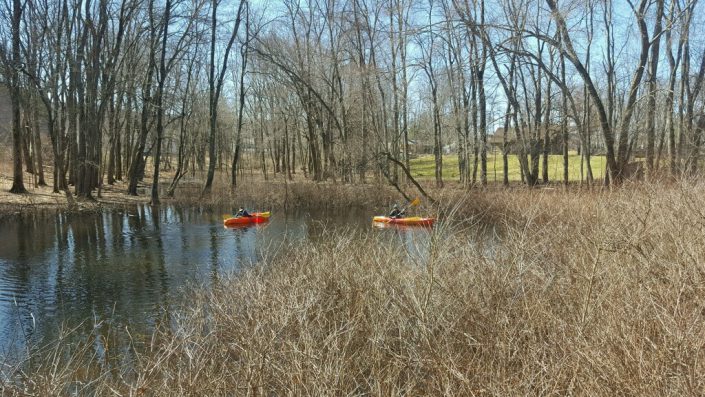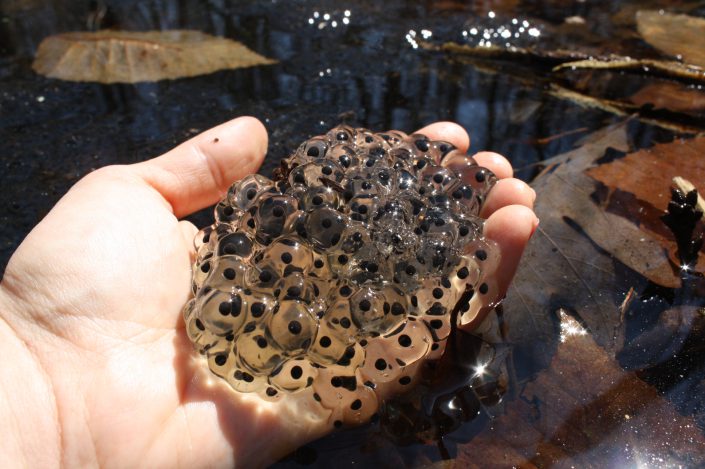What’s Happening at Waterloo?
By Allegra Mitchell, CWF Biologist
Waterloo Village in Byram Township, Sussex County is more than a tourist attraction and local gem, it is also home to the largest cross-road amphibian migration in New Jersey. Each spring, frogs, toads, and salamanders stir from their hibernation to make their way to their breeding sites. Some of these sites, like the one at Waterloo, are vernal pools – small, temporary bodies of water that appear in early spring as snow melts and rain and groundwater gathers, and disappear throughout the summer as they evaporate. The ephemeral nature of these pools can’t support fish, which would prey on amphibian eggs and larvae. Vernal pools therefore provide some protection for amphibian offspring, with many species such as wood frogs and spotted and Jefferson salamanders – both of which are listed as New Jersey species of Special Concern – relying exclusively on these vernal pools for breeding.

The greatest challenge for amphibians breeding at Waterloo Historic Village is crossing Waterloo Road. Living in the most densely population state takes a toll on many species of wildlife in the form of habitat loss, degradation, and fragmentation. Each year, many amphibians become victim to vehicular collision as they move from their hibernation sites across Waterloo Road to the vernal pool in which they reproduce. Amphibians may be disproportionately affected by vehicle-caused road mortalities compared to other wildlife because of their tendency to migrate en masse to breeding sites. These annual road mortalities can have devastating effects on amphibian population sizes, especially for the local at-risk salamander populations. In fact, as little as about 10% annual risk of road mortality in spotted salamanders can lead to the local extinction of an entire population.

To address this problem, the Conserve Wildlife Foundation of New Jersey (CWF) and the New Jersey Endangered and Nongame Species Program (ENSP) organized amphibian rescue efforts. Since 2002, dedicated volunteers have assisted frogs, toads, and salamanders across Waterloo Road during the busiest migration nights. This aid has proven effective in reducing amphibian road mortalities, but it is not a permanent solution to the problem. Efforts are underway to construct under-road tunnels to help guide amphibians safely across Waterloo Road. These tunnels will provide safe passage for these critters throughout the breeding season, including on their migration back into the woods where they will hibernate. Since this return migration is more sporadic and less weather-dependent than migration to the vernal pool, it is much harder to protect amphibians as they make their way back to the forest.

This year, CWF scientists have begun the initial phases of research to understand current amphibian population sizes and the impact of vehicle traffic on these animals at Waterloo. Scientists and volunteers have been out 7 days a week since amphibian migrations began in late February to tally daily roadkill on Waterloo Road. This study will be used to evaluate changes to frog, toad, and salamander populations as the under-road amphibian tunnels are installed. CWF scientists have also conducted egg mass counts in the vernal pool at Waterloo Village to estimate the current population sizes of the different amphibian species in the area. Having this knowledge will allow CWF to improve on future projects to minimize road-related human-wildlife conflicts.

Along with improving conditions for amphibians in this location, CWF’s work at Waterloo Village will serve as an example of New Jersey statewide initiatives to reconnect wildlife habitat as a part of the Connecting Habitat Across New Jersey (CHANJ) program. The goal of CHANJ is to make our state landscapes more permeable to wildlife movement so that all of New Jersey’s residents – human and wildlife – will have the space they need to thrive.
In an effort to bring people and wildlife together in a positive way at Waterloo Village, CWF scientists are leading educational walks for the public and local schools. Through hands-on interaction, local residents can learn about and appreciate the remarkable wildlife right in their own back yards and what they can do to support conservation efforts.
All New Jerseyans can help wildlife this season by planting native plants for their gardens, building bat boxes where bats can roost, and, of course, by keeping an eye out on the roads, especially on warm, rainy nights when amphibians might be migrating.
LEARN MORE
Allegra Mitchell is a biologist for Conserve Wildlife Foundation of New Jersey.
Discover more from Conserve Wildlife Foundation of NJ
Subscribe to get the latest posts sent to your email.